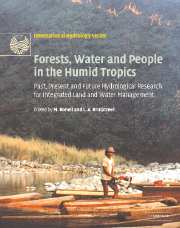 Forests, Water and People in the Humid Tropics
Forests, Water and People in the Humid Tropics Published online by Cambridge University Press: 12 January 2010
SUMMARY
This section contains four chapters providing a critical assessment of existing guidelines (also called best management practices) that have been designed to minimise adverse effects on soils and streams during timber harvesting and land clearing operations in areas with tropical forest, as well as under rainfed cropping in deforested tropical steeplands. In addition, the main factors hampering the widespread application of these best management practices are examined in some detail and areas indicated requiring additional research.
Cassells and Bruijnzeel provide an overview of guidelines aiming to minimise adverse impacts on the residual vegetation, soils and streams during tropical timber harvesting operations. Research and land management experience over many decades have demonstrated that poorly planned or managed logging operations generally have deleterious environmental impacts. Most commonly, logging and the associated road construction lead to problems with erosion and sedimentation, and thus to a reduction in the quality of streamwater and aquatic habitat. At the same time, there is considerable evidence indicating that, provided forest managers and planners respect broad land capability limits, appropriately managed logging operations can be compatible with the maintenance of good quality water supplies. In this regard, experience has shown that particular attention needs to be given to the careful location of roads, extraction trails and stream crossings; minimising ground disturbance and maintaining effective ground cover; as well as maintaining undisturbed buffer strips (as stressed by Connolly and Pearson; Hamilton) around key streams and waterways.
To save this book to your Kindle, first ensure no-reply@cambridge.org is added to your Approved Personal Document E-mail List under your Personal Document Settings on the Manage Your Content and Devices page of your Amazon account. Then enter the ‘name’ part of your Kindle email address below. Find out more about saving to your Kindle.
Note you can select to save to either the @free.kindle.com or @kindle.com variations. ‘@free.kindle.com’ emails are free but can only be saved to your device when it is connected to wi-fi. ‘@kindle.com’ emails can be delivered even when you are not connected to wi-fi, but note that service fees apply.
Find out more about the Kindle Personal Document Service.
To save content items to your account, please confirm that you agree to abide by our usage policies. If this is the first time you use this feature, you will be asked to authorise Cambridge Core to connect with your account. Find out more about saving content to Dropbox.
To save content items to your account, please confirm that you agree to abide by our usage policies. If this is the first time you use this feature, you will be asked to authorise Cambridge Core to connect with your account. Find out more about saving content to Google Drive.